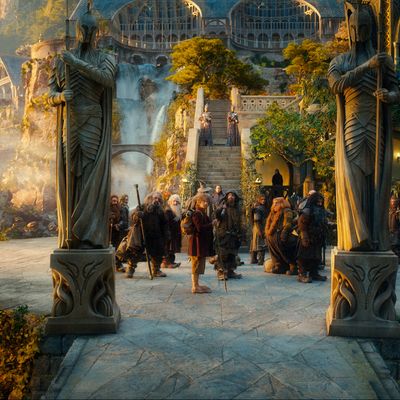
In his review of The Hobbit, David Edelstein wrote: “How nice it would be to weigh in on Peter Jackson’s The Hobbit without having to lament its newfangled double-speed 3-D 48-frames-per-second projection rate, which must be seen to be disbelieved.” (The Hobbit was shot at 48 FPS, as opposed to 24 FPS, which has been the cinema standard for a century. Jackson did this because 48 FPS offers a much sharper image that more mimics how we see the real world. It will only be shown at 48 FPS in certain theaters, though, and only in 3D. The majority of theaters will show it in a 24 FPS version.) Edelstein’s is a negative sentiment implicitly echoed by essentially every single film critic, who all strived to come up with the perfect way to explain why 48 FPS was so problematic. (Read also our conversation with a professor of optometry and vision science and a professor of computer science and engineering about why scientifically it’s so problematic.) And yet, they often landed on similar analogies. Here is a rundown of the most common comparisons.
Video Games
“At first, in the Smaug battle, I thought I was watching a video game: pellucid pictures of indistinct creatures.” – Time
“One thing The Hobbit is not is a celebration of the beauty of film. A celebration of video-game realms, perhaps.” – Philadelphia Inquirer
“There are scenes when it causes the images to be crisper and brighter but, especially in instances of high CGI content, it creates a non-cinematic picture. That may be the primary reason why isolated moments feel like video game outtakes.” – ReelViews
HD TV
“Available for viewing only in select cinemas in major cities (the rest will feature a standard 24-frame presentation), this ‘high-frame rate’ Hobbit features exceptionally sharp, plasticine images the likes of which we might never have seen on a movie screen before, but which do resemble what we see all the time on our HD television screens, whether it’s Sunday Night Football, Dancing With the Stars, or a game of Grand Theft Auto. (Indeed, most TVs now have a menu setting that can, if you so desire, lend this look to everything you watch—a setting appropriately christened by some gearheads as the ‘soap opera effect.’)” – Village Voice
“The 3-D film will be presented in select theaters at 48 frames per second — twice the normal rate — an innovation that renders images as unnaturally crisp and clear as an over-amped hi-def LED screen.” – Minneapolis Star Tribune
“Depending on lighting, backgrounds and other factors, it can deliver that sheen that one associates with bizarrely calibrated HD displays in big-box stores.” – MSN
“Audiences looking for a rich, textured, cinematic experience will be put off and disconcerted by an image that looks more like an advanced version of high definition television than a traditional movie.” – L.A. Times
“It was still like watching a very expensively mounted live TV show on the world’s largest home TV screen.”— Time
“Couple that with 3D and the movie looks so hyper-real that you see everything that’s fake about it, from painted sets to prosthetic noses. The unpleasant effect is similar to watching a movie on a new HD home-theater monitor, shadows obliterated by blinding light – yikes! – reality TV.” – Rolling Stone
“The clarity creates a sense of hyper-reality that reminded me of the first time I saw an LED TV.” – The Dallas Morning News
“The rest of us will be reminded of high-definition television — better known, in my household, as a reason to avoid viewing films on TV, unless they contain characters named Woody and Buzz.” – The New Yorker
Theater
“The immediacy of the actors is startling, but the background is weirdly foreshortened, the fakeness of the sets and makeup an endless distraction. Staginess does nothing for a fantasy-film epic … the grandeur of the Lord of the Rings trilogy having been replaced by something that resembles tatty summer-stock theater.” – David Edelstein, New York
“The Hobbit in the 48 format resembles an incredibly high-definition simulcast of “The Metropolitan Opera Live from Middle-earth.” – Chicago Tribune
“At 48 frames, the film is more true to life, sometimes feeling so intimate it’s like watching live theater. That close-up perspective also brings out the fakery of movies. Sets and props look like phony stage trappings at times, the crystal pictures bleaching away the painterly quality of traditional film.” – Associated Press
“While striking in some of the big spectacle scenes, predominantly looked like ultra-vivid television video, paradoxically lending the film an oddly theatrical look, especially in the cramped interior scenes in Bilbo Baggins’ home.” – The Hollywood Reporter
“Instead of the romantic illusion of film, we see the sets and makeup for what they are. The effect is like stepping into a diorama alongside the actors, which is not as pleasant as it might sound.” – Minneapolis Star Tribune
“The high frame rate, or HFR, version of The Hobbit has such crystalline, videolike clarity that it reduces everything and everybody to mere props and actors. Swords lack heft, the castles look like dioramas.” – Newsday
“Watching 48fps is a bit disconcerting at first, a bit like gazing at a high-definition TV showing a live theatre presentation.” – Toronto Star
Home Movie
“Consequently, everything takes on an overblown, artificial quality in which the phoniness of the sets and costumes becomes obvious, while well-lit areas bleed into their surroundings, like watching a high-end home movie.” – Variety
“The best way I can think to describe the quality of the 48fps image in The Hobbit is this: It looks like an ’80s-era home video shot by someone who happened to be standing around on set while The Hobbit was being filmed.” – Slate
Documentary
“Instead of feeling like we’ve been transported to Middle-earth, it’s as if we’ve dropped in on Jackson’s New Zealand set, trapped in an endless ‘making of’ documentary, waiting for the real movie to start.” – Village Voice
“The technique seems more suited to a documentary about the making of the movie than a whimsically inventive tale.” – USA Today
“HD has the unfortunate effect of turning every film into what appears to be a documentary about a film set, not just warts-and-all but carefully supplying extra warts where a wart has no right to be.” – The New Yorker
Other
“Over all, though, the shiny hyper-reality robs Middle-earth of some of its misty, archaic atmosphere, turning it into a gaudy high-definition tourist attraction.” – New York Times
“The best single description of which came in a tweet from Salon contributor Bob Calhoun: It looks like Jehovah’s Witness art.” — Salon
“More than anything, it resembles an insanely high-end Masterpiece Theatre production: I, Claudius with a big budget and endless banks of computers.” – Boston Globe
“Other visual analogues scribbled down in my screening notes include Teletubbies and daytime soap operas.” – Slate


